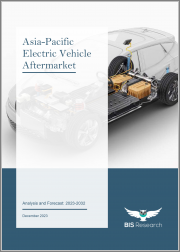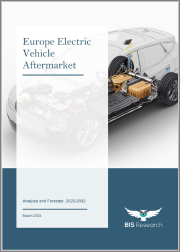
|
시장보고서
상품코드
1393903
아시아태평양의 전기자동차 애프터마켓 - 분석 및 예측(2023-2032년)Asia-Pacific Electric Vehicle Aftermarket - Analysis and Forecast, 2023-2032 |
||||||
아시아태평양 전기자동차 애프터마켓(중국 제외) 시장 규모는 2022년 149억 3,000만 달러에서 2032년 762억 3,000만 달러에 달하고, 예측 기간인 2023-2032년 CAGR은 17.95%에 달할 것으로 예상됩니다.
전기차 커스터마이징에 대한 고객 수요 증가, 전기차 세컨드 라이프 애플리케이션의 수용 확대, 전기차 인기 상승으로 전기자동차 애프터마켓이 확대될 것으로 예상됩니다.
| 주요 시장 통계 | |
|---|---|
| 예측 기간 | 2023-2032년 |
| 2023년 평가액 | 172억 5,000만 달러 |
| 2032년 전망 | 762억 3,000만 달러 |
| CAGR | 17.95% |
전기차의 급속한 보급, 전기차의 세컨드 라이프 용도로의 재사용 추세 확대, 전기차의 개인화에 대한 소비자의 관심 증가 등 여러 가지 요인이 전기자동차 애프터마켓을 견인하고 있습니다.
전기자동차 애프터마켓 솔루션 공급업체와 벤더들은 연구개발(R&D)에 대한 막대한 투자와 전기자동차 생태계의 다른 중요한 참여업체들과의 협력을 통해 전기자동차용 애프터마켓 솔루션 공급업체들은 전기자동차용 최첨단 애프터마켓 솔루션을 제공하기 위해 노력하고 있습니다. 전기자동차 애프터마켓 솔루션에 대한 수요는 전기자동차에 대한 수요의 급속한 증가, 정책, 보조금 및 투자에 대한 정부 기관의 중요성 증가, 탈탄소화를 향한 자동차 제조업체의 전환 등 여러 요인으로 인해 검토 기간 동안 크게 증가할 것으로 예상됩니다.
이 보고서는 아시아태평양의 전기자동차 애프터마켓에 대해 조사했으며, 시장 개요와 함께 차량 유형별, 추진 유형별, 판매점별, 판매 방법별, 부품별, 지역별 동향, 시장 진입 기업 개요 등을 제공합니다.
목차
제1장 시장
- 업계 전망
- 비지니스 역학
제2장 지역
- 중국
- 아시아태평양과 일본
제3장 시장 - 경쟁 벤치마킹과 기업 개요
- 경쟁 벤치마킹
- 주요 시장 기업 순위
- 기업 개요
- NTN Corporation
- AISIN Corporation
- DENSO Corporation
- GUD Holdings Limited
- Bridgestone Corporation
- The Yokohama Rubber Co., Ltd.
- Akebono Brake Industry Co., Ltd.
- 기타
제4장 조사 방법
- 데이터 소스
- 시장 추정과 예측
“The Asia-Pacific Electric Vehicle Aftermarket (excluding China) Expected to Reach $76.23 Billion by 2032.”
Introduction to Asia-Pacific Electric Vehicle Aftermarket
The Asia-Pacific electric vehicle aftermarket (excluding China) is projected to reach $76.23 billion by 2032 from $14.93 billion in 2022, growing at a CAGR of 17.95% during the forecast period 2023-2032. Rising customer demand for electric vehicle customization, growing acceptance of electric vehicle second-life applications, and growing popularity of electric vehicles are anticipated to fuel the expansion of the aftermarket for electric vehicles.
| KEY MARKET STATISTICS | |
|---|---|
| Forecast Period | 2023 - 2032 |
| 2023 Evaluation | $17.25 Billion |
| 2032 Forecast | $76.23 Billion |
| CAGR | 17.95% |
Market Introduction
A number of factors, including the rapid uptake of electric vehicles, the expanding trend of repurposing electric vehicles for second-life applications, and the growing consumer interest in personalizing electric vehicles, are driving the electric vehicle aftermarket.
Through large investments in research and development (R&D) and collaborations with other important players in the electric vehicle ecosystem, suppliers and vendors of aftermarket solutions for electric vehicles are striving to provide cutting-edge aftermarket solutions for electric vehicles. The demand for electric vehicle aftermarket solutions is expected to rise significantly during the review period due to a number of factors, including the rapidly rising demand for electric vehicles, the governing bodies' increasing emphasis on policies, subsidies, and investment, and the automakers' shifting focus towards decarbonization.
Market Segmentation:
Segmentation 1: by Vehicle Type
- Passenger Vehicles
- Commercial Vehicles
Segmentation 2: by Propulsion Type
- Battery Electric Vehicles (BEVs)
- Plug-In Hybrid Electric Vehicles (PHEVs)
- Hybrid Electric Vehicles (HEVs)
Segmentation 3: by Sales Outlet
- Authorized Service Centers
- Premium Multi-brand Service Centers
- Others
Segmentation 4: by Mode of Sales
- Offline sales
- Online sales
Segmentation 5: by Part
- Batteries
- Tires and Wheels
- Brakes and Suspensions
- Body Parts
- Others
Segmentation 6: by Region
- China
- Asia-Pacific and Japan
How can this report add value to an organization?
Product/Innovation Strategy: The product strategy helps the readers understand the different aftermarket solutions provided by the industry participants.
Growth/Marketing Strategy: The electric vehicle aftermarket is growing at a significant pace and holds enormous opportunities for market players. Some of the strategies covered in this segment are product launches, partnerships, collaborations, business expansions, and investments. The companies' preferred strategy has been product launches, partnerships, and collaborations to strengthen their positions in the global electric vehicle aftermarket.
Competitive Strategy: The key players in the Asia-Pacific electric vehicle aftermarket analyzed and profiled in the study include electric vehicle aftermarket solution providers that develop parts and accessories for EVs. Moreover, a detailed competitive benchmarking of the players operating in the electric vehicle aftermarket has been done to help the reader understand the ways in which players stack against each other, presenting a clear market landscape. Additionally, comprehensive competitive strategies such as partnerships, agreements, and collaborations are expected to aid the reader in understanding the untapped revenue pockets in the market.
Key Market Players and Competition Synopsis
The companies that are profiled have been selected based on inputs gathered from primary experts and analyzing company coverage, product portfolio, and regional presence.
Some of the prominent names in this market are:
|
|
Table of Contents
1 Markets
- 1.1 Industry Outlook
- 1.1.1 Trends: Current and Future
- 1.1.1.1 Electrification of Fleets
- 1.1.1.2 Governments Increase their Influence on the e-Mobility Industry
- 1.1.2 Electric Vehicle Aftermarket Structure
- 1.1.3 Ecosystem/Ongoing Programs
- 1.1.3.1 Consortiums, Associations, and Regulatory Bodies for Electric Vehicles
- 1.1.3.2 Programs on Electric Vehicles by Research Institutions and Universities
- 1.1.4 Automotive Aftermarket Dynamics
- 1.1.4.1 Declining Demand for Traditional Engines and Drivetrains
- 1.1.4.2 New Opportunities for Industry Players through Electric Vehicle Aftermarket across the Board
- 1.1.1 Trends: Current and Future
- 1.2 Business Dynamics
- 1.2.1 Business Drivers
- 1.2.1.1 Rising Popularity of Electric Vehicles
- 1.2.1.2 Proliferating Consumer Demand for Electric Vehicle Customization
- 1.2.1.3 Increasing Popularity of Electric Vehicle Second-Life Applications
- 1.2.2 Business Challenges
- 1.2.2.1 Lack of Electric Vehicle Aftermarket Infrastructure and Awareness
- 1.2.2.2 Cost and Availability Issues of Electric Vehicle Spare Parts
- 1.2.3 Business Strategies
- 1.2.3.1 Product Development
- 1.2.3.2 Market Development
- 1.2.4 Corporate Strategies
- 1.2.4.1 Mergers and Acquisitions
- 1.2.4.2 Partnerships, Collaborations, and Joint Ventures
- 1.2.5 Business Opportunities
- 1.2.5.1 Electric Vehicle Battery Repair and Replacement
- 1.2.5.2 EV Component Recycling and Disposal
- 1.2.5.3 Training and Education on Electric Vehicle Aftermarket
- 1.2.5.4 Shifting Trend toward E-commerce
- 1.2.1 Business Drivers
2 Regions
- 2.1 China
- 2.1.1 Market
- 2.1.1.1 Buyer Attributes
- 2.1.1.2 Key Solution Providers in China
- 2.1.1.3 Business Challenges
- 2.1.1.4 Business Drivers
- 2.1.2 Application
- 2.1.2.1 China Electric Vehicle Aftermarket (by Vehicle Type), Value Data
- 2.1.2.2 China Electric Vehicle Aftermarket (by Propulsion Type), Value Data
- 2.1.3 Product
- 2.1.3.1 China Electric Vehicle Aftermarket (by Sales Outlet), Value Data
- 2.1.3.2 China Electric Vehicle Aftermarket (by Mode of Sales), Value Data
- 2.1.3.3 China Electric Vehicle Aftermarket (by Part), Value Data
- 2.1.1 Market
- 2.2 Asia-Pacific and Japan
- 2.2.1 Market
- 2.2.1.1 Buyer Attributes
- 2.2.1.2 Key Solution Providers in Asia-Pacific and Japan
- 2.2.1.3 Business Challenges
- 2.2.1.4 Business Drivers
- 2.2.2 Application
- 2.2.2.1 Asia-Pacific and Japan Electric Vehicle Aftermarket (by Vehicle Type), Value Data
- 2.2.2.2 Asia-Pacific and Japan Electric Vehicle Aftermarket (by Propulsion Type), Value Data
- 2.2.3 Product
- 2.2.3.1 Asia-Pacific and Japan Electric Vehicle Aftermarket (by Sales Outlet), Value Data
- 2.2.3.2 Asia-Pacific and Japan Electric Vehicle Aftermarket (by Mode of Sales), Value Data
- 2.2.3.3 Asia-Pacific and Japan Electric Vehicle Aftermarket (by Part), Value Data
- 2.2.4 Asia-Pacific and Japan (by Country)
- 2.2.4.1 Japan
- 2.2.4.1.1 Market
- 2.2.4.1.1.1 Buyer Attributes
- 2.2.4.1.1.2 Key Solution Providers in Japan
- 2.2.4.1.1.3 Business Challenges
- 2.2.4.1.1.4 Business Drivers
- 2.2.4.1.2 Application
- 2.2.4.1.2.1 Japan Electric Vehicle Aftermarket (by Vehicle Type), Value Data
- 2.2.4.1.2.2 Japan Electric Vehicle Aftermarket (by Propulsion Type), Value Data
- 2.2.4.1.3 Product
- 2.2.4.1.3.1 Japan Electric Vehicle Aftermarket (by Sales Outlet), Value Data
- 2.2.4.1.3.2 Japan Electric Vehicle Aftermarket (by Mode of Sales), Value Data
- 2.2.4.1.3.3 Japan Electric Vehicle Aftermarket (by Part), Value Data
- 2.2.4.1.1 Market
- 2.2.4.2 South Korea
- 2.2.4.2.1 Market
- 2.2.4.2.1.1 Buyer Attributes
- 2.2.4.2.1.2 Key Solution Providers in South Korea
- 2.2.4.2.1.3 Business Challenges
- 2.2.4.2.1.4 Business Drivers
- 2.2.4.2.2 Application
- 2.2.4.2.2.1 South Korea Electric Vehicle Aftermarket (by Vehicle Type), Value Data
- 2.2.4.2.2.2 South Korea Electric Vehicle Aftermarket (by Propulsion Type), Value Data
- 2.2.4.2.3 Product
- 2.2.4.2.3.1 South Korea Electric Vehicle Aftermarket (by Sales Outlet), Value Data
- 2.2.4.2.3.2 South Korea Electric Vehicle Aftermarket (by Mode of Sales), Value Data
- 2.2.4.2.3.3 South Korea Electric Vehicle Aftermarket (by Part), Value Data
- 2.2.4.2.1 Market
- 2.2.4.3 Australia
- 2.2.4.3.1 Market
- 2.2.4.3.1.1 Buyer Attributes
- 2.2.4.3.1.2 Key Solution Providers in Australia
- 2.2.4.3.1.3 Business Challenges
- 2.2.4.3.1.4 Business Drivers
- 2.2.4.3.2 Application
- 2.2.4.3.2.1 Australia Electric Vehicle Aftermarket (by Vehicle Type), Value Data
- 2.2.4.3.2.2 Australia Electric Vehicle Aftermarket (by Propulsion Type), Value Data
- 2.2.4.3.3 Product
- 2.2.4.3.3.1 Australia Electric Vehicle Aftermarket (by Sales Outlet), Value Data
- 2.2.4.3.3.2 Australia Electric Vehicle Aftermarket (by Mode of Sales), Value Data
- 2.2.4.3.3.3 Australia Electric Vehicle Aftermarket (by Part), Value Data
- 2.2.4.3.1 Market
- 2.2.4.4 Rest-of-Asia-Pacific and Japan
- 2.2.4.4.1 Market
- 2.2.4.4.1.1 Buyer Attributes
- 2.2.4.4.1.2 Key Solution Providers in Rest-of-Asia-Pacific and Japan
- 2.2.4.4.1.3 Business Challenges
- 2.2.4.4.1.4 Business Drivers
- 2.2.4.4.2 Application
- 2.2.4.4.2.1 Rest-of-Asia-Pacific and Japan Electric Vehicle Aftermarket (by Vehicle Type), Value Data
- 2.2.4.4.2.2 Rest-of-Asia-Pacific and Japan Electric Vehicle Aftermarket (by Propulsion Type), Value Data
- 2.2.4.4.3 Product
- 2.2.4.4.3.1 Rest-of-Asia-Pacific and Japan Electric Vehicle Aftermarket (by Sales Outlet), Value Data
- 2.2.4.4.3.2 Rest-of-Asia-Pacific and Japan Electric Vehicle Aftermarket (by Mode of Sales), Value Data
- 2.2.4.4.3.3 Rest-of-Asia-Pacific and Japan Electric Vehicle Aftermarket (by Part), Value Data
- 2.2.4.4.1 Market
- 2.2.4.1 Japan
- 2.2.1 Market
3 Markets - Competitive Benchmarking & Company Profiles
- 3.1 Competitive Benchmarking
- 3.1.1 Key Market Player Ranking
- 3.1.1.1 Key Market Player Ranking: Automotive Tires
- 3.1.1.2 Key Market Player Ranking: Automotive Brakes
- 3.1.1.3 Key Market Player Ranking: Electric Vehicle Batteries
- 3.1.1.4 Key Market Player Ranking: Automotive Wipers
- 3.1.1.5 Key Market Player Ranking: Automotive Lighting
- 3.1.1 Key Market Player Ranking
- 3.2 Company Profiles
- 3.2.1 NTN Corporation
- 3.2.1.1 Company Overview
- 3.2.1.1.1 Role of NTN Corporation in Electric Vehicle Aftermarket
- 3.2.1.1.2 Product Portfolio
- 3.2.1.1.3 Company Offices
- 3.2.1.1.4 R&D Analysis
- 3.2.1.2 Business Strategies
- 3.2.1.2.1 Product Development
- 3.2.1.3 Analyst View
- 3.2.1.1 Company Overview
- 3.2.2 AISIN Corporation
- 3.2.2.1 Company Overview
- 3.2.2.1.1 Role of AISIN Corporation in the Electric Vehicle Aftermarket
- 3.2.2.1.2 Product Portfolio
- 3.2.2.1.3 R&D Analysis
- 3.2.2.1.4 Company Offices
- 3.2.2.2 Analyst View
- 3.2.2.1 Company Overview
- 3.2.3 DENSO Corporation
- 3.2.3.1 Company Overview
- 3.2.3.1.1 Role of DENSO Corporation in the Electric Vehicle Aftermarket
- 3.2.3.1.2 Product Portfolio
- 3.2.3.1.3 R&D Analysis
- 3.2.3.1.4 Company Offices
- 3.2.3.2 Corporate Strategies
- 3.2.3.2.1 Partnership, Collaboration, and Joint Venture
- 3.2.3.3 Analyst View
- 3.2.3.1 Company Overview
- 3.2.4 GUD Holdings Limited
- 3.2.4.1 Company Overview
- 3.2.4.1.1 Role of GUD Holdings Limited in the Electric Vehicle Aftermarket
- 3.2.4.1.2 Product Portfolio
- 3.2.4.1.3 R&D Analysis
- 3.2.4.1.4 Company Offices
- 3.2.4.2 Analyst View
- 3.2.4.1 Company Overview
- 3.2.5 Bridgestone Corporation
- 3.2.5.1 Company Overview
- 3.2.5.1.1 Role of Bridgestone Corporation in the Electric Vehicle Aftermarket
- 3.2.5.1.2 Product Portfolio
- 3.2.5.1.3 R&D Analysis
- 3.2.5.1.4 Company Offices
- 3.2.5.2 Business Strategies
- 3.2.5.2.1 Market Development
- 3.2.5.3 Corporate Strategies
- 3.2.5.3.1 Partnership, Collaboration, and Joint Venture
- 3.2.5.4 Analyst View
- 3.2.5.1 Company Overview
- 3.2.6 The Yokohama Rubber Co., Ltd.
- 3.2.6.1 Company Overview
- 3.2.6.1.1 Role of The Yokohama Rubber Co., Ltd. in the Electric Vehicle Aftermarket
- 3.2.6.1.2 Product Portfolio
- 3.2.6.1.3 R&D Analysis
- 3.2.6.1.4 Company Offices
- 3.2.6.2 Business Strategies
- 3.2.6.2.1 Product Development
- 3.2.6.2.2 Market Development
- 3.2.6.3 Corporate Strategies
- 3.2.6.3.1 Partnership, Collaboration, and Joint Venture
- 3.2.6.4 Analyst View
- 3.2.6.1 Company Overview
- 3.2.7 Akebono Brake Industry Co., Ltd.
- 3.2.7.1 Company Overview
- 3.2.7.1.1 Role of Akebono Brake Industry Co., Ltd. in the Electric Vehicle Aftermarket
- 3.2.7.1.2 Product Portfolio
- 3.2.7.1.3 R&D Analysis
- 3.2.7.1.4 Company Offices
- 3.2.7.2 Corporate Strategies
- 3.2.7.2.1 Partnership, Collaboration, and Joint Venture
- 3.2.7.3 Analyst View
- 3.2.7.1 Company Overview
- 3.2.1 NTN Corporation
- 3.3 Other Companies
4 Research Methodology
- 4.1 Data Sources
- 4.1.1 Primary Data Sources
- 4.1.2 Secondary Data Sources
- 4.1.3 Data Triangulation
- 4.2 Market Estimation and Forecast
- 4.2.1 Factors for Data Prediction and Modeling














